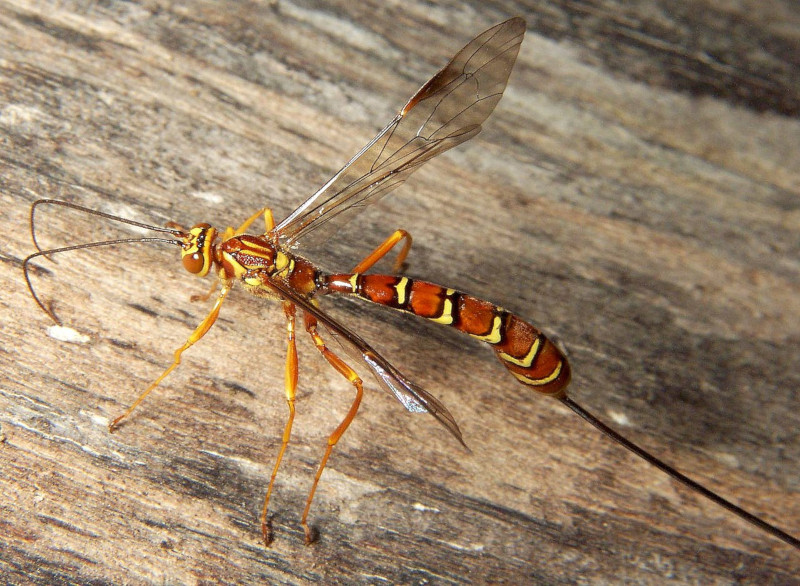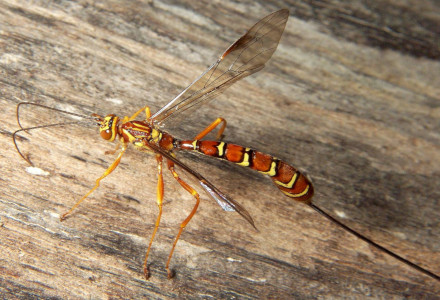
Giant Ichneumon Wasp Facts
- The attention-grabbing term of Giant Ichneumon Wasp perfectly serves as the most accepted common name for a distinctive insect. It does possess an alternate common name, though. That’s the comical, but accurate, term of the stump stabber.
- As difficult as the most often used term may seem, it’s somewhat easier to pronounce than the scientific name of the species. That’s due to the fact that its official name remains that of the Megarhyssa macrurus. Neither choice is easy to use.
- By either of these tongue-twisting names, though, it remains a most impressive variety of invertebrate. As a member of the Megarhyssa genus, it shares a remarkable trait. It, along with its related creatures, has an incredibly long ovipositor.
- For the moment, unlike many other species, the Giant Ichneumon Wasp appears to be maintaining a stable population base. The IUCN therefore does not currently have a listing for it. Any such listing would appear on the organization’s Red List.
- Yet, it could be considered to be facing at least some risks. Although it has a respectable range, much of its habitat remains at risk. As a result, the arthropod could face danger in the future, primarily in the form of habitat loss and climate change.
Related Articles
Giant Ichneumon Wasp Physical Description
The fascinating Giant Ichneumon Wasp has a most distinctive physical appearance. It also displays the physiological trait of sexual dimorphism. In its particular case, however, like many members of its genus, this principle manifests itself in two separate ways.
Firstly, the body of the male attains a slightly smaller size than that of the female. She reaches a body length of roughly 2 in (5 cm), with him lagging slightly behind. Secondly, the male has no ovipositor at all. In the female, this can reach 3 in (7.6 cm) in length.
Otherwise, both genders of the amazing Giant Ichneumon Wasp share basically identical appearances. The basic color pattern of the body presents as a reddish-brown shade. This has a relatively dense covering of yellow-orange and black stripes, however.
Both males and females further develop powerful wings, and rank as skilled fliers. Again mimicking its related species, the wings remain transparent in nature. Finally, the body of the awesome arthropod itself possesses a thin, highly elongated shape.
- Kingdom: Animalia
- Phylum: Arthropoda
- Class: Insecta
- Order: Hymenoptera
- Family: Ichneumonidae
- Genus: Megarhyssa
- Species: M. macrurus
Giant Ichneumon Wasp Distribution, Habitat, and Ecology
Among its many kindred species, the truly remarkable Giant Ichneumon Wasp inhabits a comparatively wide section of the world. That’s due to the fact that this wonder of nature and evolution appears in moderately large portions of the continent of North America.
More precisely, the great majority of its native range consists of the eastern half of the United States. However, this zone of habitation does reach into one other country. The northern most part of its range enters the extreme south of Canada, close to the Great Lakes.
Within that relatively extensive range, the insect appears to be reasonably adaptable to varying habitats. Generally, individuals thrive in any reasonably wooded region of that territory. That frequently even includes areas such as public parks and even yards.
Although it appears at most altitudes in the region of the world it inhabits, it does shy away from certain areas. More precisely, it typically avoids regions of hot, arid deserts. It also avoids areas without a sufficiently extensive concentration of trees, such as the plains.
That’s due to the basic nature and needs of the Giant Ichneumon Wasp. Although it remains totally harmless to humans, the larvae of the species feeds as parasites. These consume the larvae of another variety of insect, while the adults do not feed at all.
Species Sharing Its Range
Check out our other articles on 5 Incredible South American Trees, Black-and-white hawk-eagle, Chandipur Beach, Purple Pitcher Plant, Geoffroy’s Cat, Flatback Sea Turtle, Wood Frog

